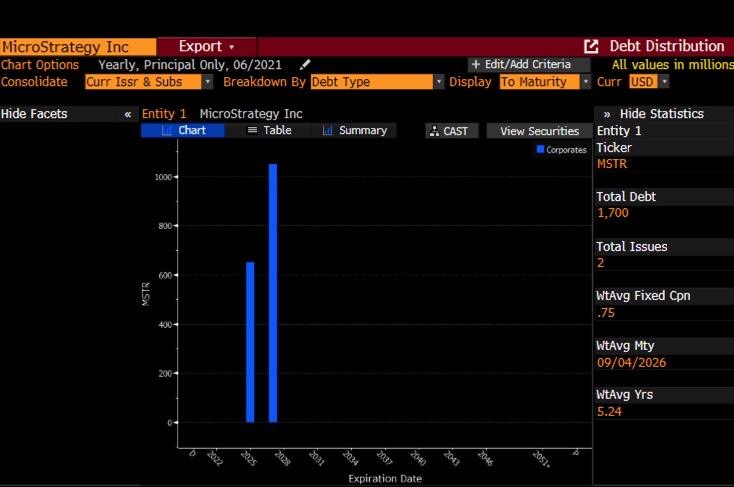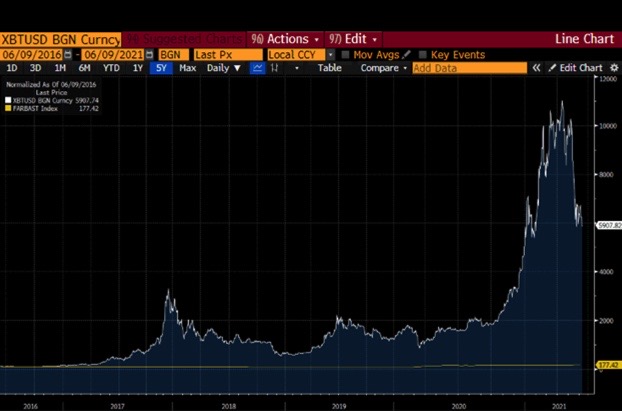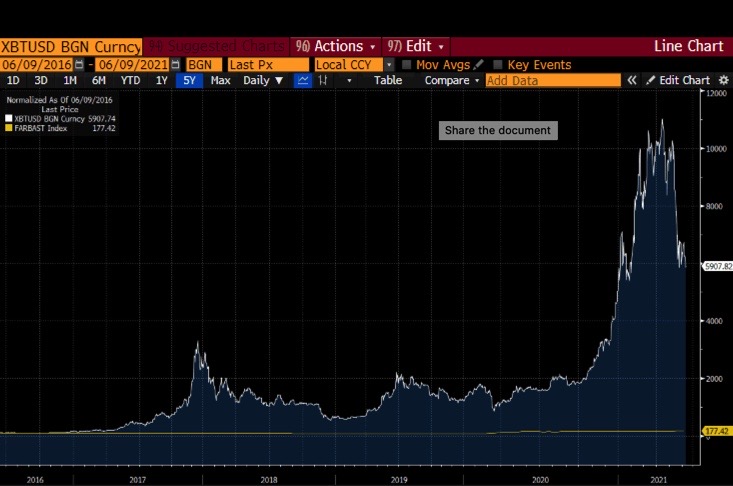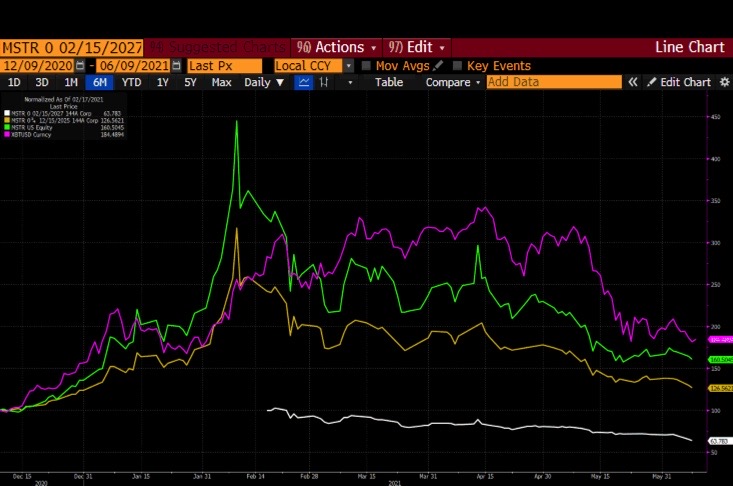(Any views expressed in the below are the personal views of the author and should not form the basis for making investment decisions, nor be construed as a recommendation or advice to engage in investment transactions.)
 The majority of my essays in 2021 have focused on the fundamental building blocks of my bullish opinion on the future of crypto. Few words are dedicated to current events unfolding before us. In an age when virtue signaling social media influencers reign supreme, critical thought that deconstructs popular narratives using logic and first principles thinking is hardly proffered. It’s why I prefer to read something a few thousand words in length – even if I disagree with the author – because the length allows the writer to dig into the grey of an issue. Few things in this world are black and white – everything is a shade of grey. 6 second TikTok videos, on the other hand, can only convey so much information.
The majority of my essays in 2021 have focused on the fundamental building blocks of my bullish opinion on the future of crypto. Few words are dedicated to current events unfolding before us. In an age when virtue signaling social media influencers reign supreme, critical thought that deconstructs popular narratives using logic and first principles thinking is hardly proffered. It’s why I prefer to read something a few thousand words in length – even if I disagree with the author – because the length allows the writer to dig into the grey of an issue. Few things in this world are black and white – everything is a shade of grey. 6 second TikTok videos, on the other hand, can only convey so much information.
Maybe I’m just an old curmudgeon who refuses to purse my lips like a duck and create thirst traps posing in front of material objects I don’t own.
In this piece, I’ll offer my thoughts on a few topics du jour that are currently floating around the popular media narrative soup. My goal is to provoke thought. None of my musings here are intended to be read as actionable trade ideas, but if one of these narratives run counter to a belief you have about a particular crypto asset, hopefully reading these words will allow for a moment of reflection that could culminate in a change in your perspective.
Keyboard Warriors Take Control of Environmental Policy
I’m glad I spend more time hitting balls with a racquet than following the tweet storm of the day. If there is one topic that fundamentally irks me, it’s the current ESG narrative – i.e. that fossil fuels are the devil, and that it is economically viable today for us to stop burning fossil fuels altogether. If followed blindly, I believe this fundamental misunderstanding will result in a significant misallocation of capital due to first level shallow thinking.
I’m not denying that burning fossil fuels has a major impact on our environment. Energy rules everything we do in life. We consume it to live and enjoy ourselves. And the ways in which we produce energy have externalities.
Here is what I know, cause I’m good at the internet.
|
In Billions of Units |
1950 |
2019 |
% Growth |
|
C02 Emissions |
6.00 |
36.44 |
507.33% |
|
Global Population |
2.50 |
7.70 |
208.00% |
|
Global GDP |
9.25 |
87.80 |
849.19% |
Fact: Since the 50’s, humans have gotten richer, and had a lot of kids. This has pushed up the global population.
Fact: Global GDP has also risen. As the world has gotten richer, it has produced more goods and services which have ultimately led to humans having an easier and more pleasurable time on this planet.
Fact: For much of the past 150 or so years, burning fossil fuels has been – and by and large, still is – the most efficient and cheapest way to produce the amount of energy required to pay for the party on a global scale.
Fact: The externality of intensive consumption of energy to fuel a better lifestyle resulted in greater carbon emissions.
If you’re a world government, what actions would you take based on this set of simple facts?
Would you tell people to have fewer kids to reduce the strain on our resources and environment? Nah. Most governments encourage families to have more kids due to a fall in the working age population.
Would you tell people to go back to living on the farm, die from curable diseases, and accept a simpler existence devoid of the modern comforts we enjoy? Doubt it. We’ve become accustomed to a certain standard of living, and we’re taught that growth is limitless, and life is a series of amazing purchases that only result in more happiness.
Would you tell the world to stop burning fossil fuels and replace it with wind and solar farms? Abso-fucking-lutely – it’s the easiest way to get the general population on board without having to directly ask them to sacrifice their own lifestyle.
As an avid skier, I love crisp clean air and a clean mountainside with a healthy portion of deep fluffy powder. The problem with this approach, and the virtue signalers in charge of our mainstream narratives, is that it ignores the fact there are more people on this planet than ever before who would like to have an enjoyable existence, necessitating the consumption of more and more energy at an affordable price. And because we haven’t figured out how to produce renewable energy affordably at a global scale, with our current infrastructure, keeping energy costs low for the masses to keep the party going likely still requires fossil fuels.
But I’m just a lowly keyboard warrior and the market has spoken.
Fossil Fuels = Bad
Wind, Solar and other renewable energies = Good
I recently started reading Doombert – it’s a pithy blog on current events delivered via email each day. This week, Doombert featured an article about energy costs. It made an interesting point that Larry Fink is now the world’s energy czar. Fink controls Blackrock, which, via the trillions of dollars of ETFs and mutual funds it administers, is the most powerful investment body globally. And Fink is all about ESG, which means providing incremental investment into the traditional oil and gas sector is forbidden.
Building and maintaining energy extraction infrastructure is extremely capital intensive. Without the public markets or direct support from governments, it is very hard to finance these companies. The payback time is too long and the sums too large for private companies to build and maintain projects. As a result, heads of large pools of capital like Fink have an outsized influence on the strategic direction of corporations and global energy policy as a whole.
People and organisations like Fink and Blackrock will starve the fossil fuels sector of resources and direct them to companies pursuing renewable projects. The question we will only know the answer to years from now is whether that empirically allows the world to produce the energy it needs at an all-in acceptable cost.
China Bans Bitcoin … Again
A few weeks ago, it was reported that large Chinese miners would face power cuts. Beijing is serious about its commitment to reducing carbon emissions. It makes sense – as people have gotten richer due to industrialisation, the negative environmental externalities produced have not been acceptable to a newly affluent class of comrades. Bitcoin miners in China use a lot of cheap coal power, and that just has to stop.
I visited a friend of mine who, perched in the perfectly manicured jungle of Bukit Timah, runs a Bitcoin mining farm using 100% renewable energy in Norway. The highlight of the visit wasn’t the information I gleaned, but that I ate my first Alphonso mango from India. They are world renowned for their sweetness and intense flavour. It’s hard to eat them outside of India because they spoil quickly. Thanks man.
Back to Bitcoin. I asked him if the exodus of miners from China was real. The community is always on edge that China will tire of supporting the mining industry and a significant amount of hash power will go “poof.” He recounted a story where a few years ago, a mining outfit approached him for hosting at his facility. He quoted a price, the miner said it was 5x more expensive than China, and that was the end of the conversation. This same miner came back recently pleading for hosting, badgering my friend for terms and offering to accept essentially whatever price is asked.
New and old mining rigs are hitting the market via a network of brokers. You can buy thousands of machines if you know the right people. Either a miner sells their rigs for something, or finds hosting internationally. Staying in China is not an option.
The ESG narrative is front and center because the most desirable locations for mining Bitcoin are those that appear to be ESG-compliant. That stamp of approval allows institutional money to check their box, and invest. Mining is extremely capital intensive, and as the crypto ecosystem matures the costs to stay competitive are only going up. Institutional capital is required to keep up with the Satoshis. Hold that thought.
Bitcoin = ESG Battery
In a world where the only green-lit projects are renewable, and only mining outfits powered by renewable sources are investable, Bitcoin mines must be in proximity to said power sources. This is powerful because the biggest problem with renewable energy is it usually isn’t harvested near population centers.
The cost of wind and solar is directly proportional to the efficiency of batteries. Battery technology is improving exponentially with the influx of attention and investor capital. However, current and proposed battery technologies require certain commodities that only a few countries possess in quantities large enough to power the ESG revolution. Unfortunately for capital, these countries are not the major global economies. The ESG revolution is yet another way to externalise the lifestyle habits of the developed world to developing countries who possess essential natural resources. The result is another small cadre of individual families who will now get to gallivant around Knightsbridge.
This article is 3 years old, but it gives a good overview of the essential metals needed to power our bright future. Let me be a bit acerbic. Our narrative gods convinced us that our renewable, carbon free energy future is dependent on pulling a massive amount of stuff from the earth. Instead of piping hydrocarbons out of the ground, we will strip mine a bunch of industrial commodities. Progress!
The notion that Bitcoin is the world’s best battery is not a new idea. The cost of storage and transport of energy from where it’s produced to where it’s consumed, is non-negligible. Bitcoin is the first true currency that is backed by electricity. The network functions via internet connected miners who consume electricity (i.e. energy) to perform computational work. It then stores energy in an abstracted form – Bitcoin – that is easily transferable.
An end-to-end Bitcoin energy economy could obviate the need for a massive buildout of close- proximity renewable energy storage. Walk with me:
-
-
- A wind farm is located in a windy part of bumblefuck. The capital for it was raised by issuing a renewable Bitcoin-denominated bond to ESG warriors who want to support renewable energy infrastructure.
- The farm is attached to a mining rig and earns Bitcoin depending on the amount of hash power it represents.
- The farm pays a coupon back to bondholders in the form of Bitcoin it has sourced from operations. The coupon is variable, and is the total sum of all Bitcoin earnings minus expenses for running the wind farm.
- Back in the city, on-demand energy is still produced using dirty fossil fuels, but it is made exorbitantly expensive in an attempt to represent its total environmental impact.
- The energy consumer, our ESG warrior, has a bad-ass Pontiac looking electric SUV (I grew up outside of Detroit, that new Tesla truck ain’t new – it’s a Pontiac). To pay for their juice, they use their Bitcoin interest earned from their renewable Bitcoin mining bond.
- The charging station is connected to the local grid and purchases power on the spot market depending on the BTC/KwH pricing – passing that pricing on with a small markup to the consumer.
-
This hypothetical energy ecosystem is more realistic. The on-demand, close-to-the-customer energy is produced using fossil fuels at a much higher price. Savvy consumers can defray high energy costs by producing energy where it’s windy or sunny, use that energy to mine Bitcoin, and then spend their earnings to power their lifestyle.
Is Michael Saylor Irresponsible or a Genius?
The answer to that question usually depends on the price of Bitcoin. That is because Saylor, CEO of Microstrategy, has transformed his company into a pseudo-Bitcoin ETF.
He had the gall in 2020 to issue $1.6 billion worth of bonds and use the proceeds to purchase Bitcoin. Oh My Fucking God!
Below is a chart of the current distribution of MSTR’s debt by year of maturity.

The 0.75% coupon convertible bond comes due on 9 December 2025. The zero coupon bond comes due on 17 February 2027. If MSTR doesn’t have the cash flow to pay back the principle, or cannot access the corporate bond market, then and only then would MSTR be forced to sell assets.
The relevant question is at what yield would it be uneconomical to refinance the bond? That is fundamentally driven by the performance of Bitcoin vs. the growth in the US money supply. As we know, that is dictated by the Federal Reserve. Using the historical returns of the past 5 years, displayed below, the refinancing rate for a 5 year bond would need to be greater than 5,808% / 5 years or 1,162% per annum. At that rate, a company is effectively shut out of the corporate bond market.

Given that MSTR has a viable cash-generating business, I find that situation highly unlikely. That is because many institutional bond investors lack common sense. They follow a set of investment mandates blindly. Therefore, even if they hate Bitcoin to its core, if MSTR corporate paper has an attractive yield vs. their benchmark, they will buy the issue up to their concentration limits. MSTR is a listed, audited company of a certain size, so its issues must be owned regardless of what the CEO does with the proceeds. That is the reflexive power of passive index investing. It’s quite smart to use the sloth of the professional investing community to invest in a concept that aims to disintermediate them.

Don’t worry, if CEO Saylor is your Ishmael, he will continue leading your portfolio through the rough seas, and will not desert you.
Bonus chart, this is the relative performance of each of MSTR’s outstanding bonds, it’s stock price, and the price of Bitcoin. Surprise, surprise – Bitcoin outperformed all of them.

CEO Saylor is not stopping the party. He will continue gorging on cheap corporate debt as long as institutional investors invest. MSTR recently priced another $500 million 6.125% coupon bond maturing in June 2028 with a yield according to <YAS> on Bloomie of 5.71%.
Hey TikTok, what’s greater, 5.71% or 1,162%? I think you can answer that in under 6 seconds.
Bravo El Salvador!
It’s too soon to use this event as the beginning of the end of blind allegiance to a global payments system that strips percentage points off a developing country’s GDP. If you didn’t hear, the President introduced a bill that just passed, making Bitcoin legal tender. He hopes that remitters can use the Bitcoin rails rather than the traditional pipes due to the high cost.
It is not a fait accompli that remitting Bitcoin in small amounts is cheaper than the incumbent solution. The truly revolutionary outcome would be for El Salvadorian domestic labour to request wages in Bitcoin. Then they would not bear the exchange costs between USD to Bitcoin.
There are many developing countries that only contribute their cheap domestic labour to the world market. The former US President might refer to these locations as “shithole countries.” In Asia, women from the Philippines, Indonesia, Myanmar and other poor ASEAN countries clean our toilets, cook our food, and take care of our children. What if they decided that they would only work for Bitcoin? Would you, as an employer, argue with them, or would you find a way to pay them in Bitcoin? It’s an interesting thought experiment – we often believe that the cheap domestic labourers who make our existence pleasant have no power. But faced with doing the things we would rather not, or acquiring some Bitcoin, I know I would make a beeline for the nearest BTC ATM.
Look at the Calendar
The FOMO was real while watching the 2021 Miami Bitcoin conference bacchanal. Should I go to my tailor and get a white suit like Max Keiser? Across the Atlantic, the Europeans are not accepting a summer without visiting their favourite Mediterranean hotspots. I’m sure Scorpios is going to be LIT this summer. Outside of the US and EU, most countries are and will continue to be in various forms of lockdown.
Currently, the marginal fiat wampum going in and out of crypto originates in the US and EU. The plebes woke up and discovered inflation is real, and it’s time to do something about it. But the summer is here.
Anytime I want to place a trade I look at the calendar. Sell in May, Go Away! It’s just that simple. The Northern Hemisphere will be on the beach, sans mask, enjoying life. Some will be spending their dog money on earthly pleasures, woof woof. Either way, they will not be sitting in front of a screen pushing buttons.
I write something to this effect every year. The drop in volatility never disappoints. And the summer doldrum effect will be even more pronounced as certain people rediscover what real human connection is outside of one’s quarantine bubble.
Don’t worry, there will be enough unappreciated summer macroeconomic fodder to be re-evaluated in the Fall. Until then, over and out.
Related
The post appeared first on Blog BitMex






